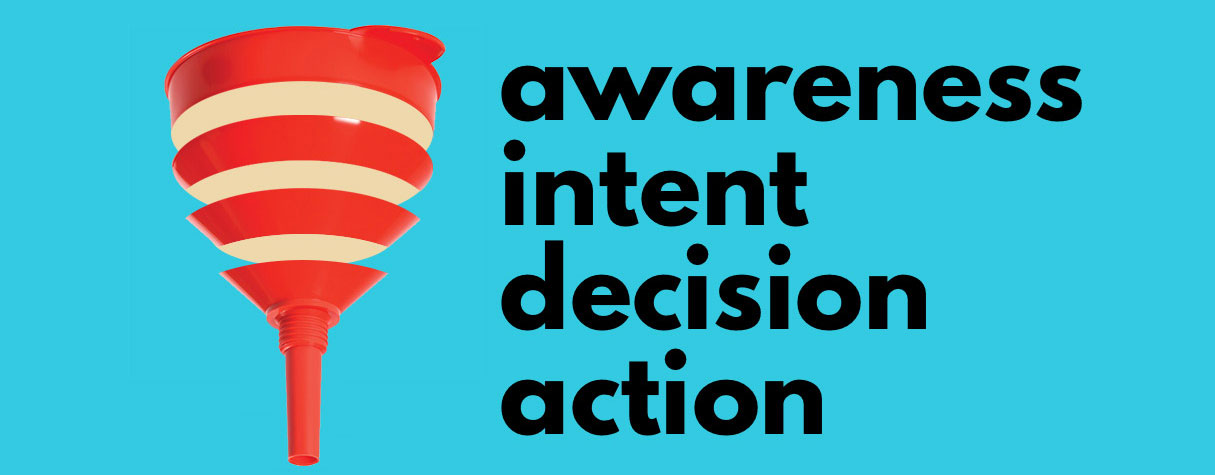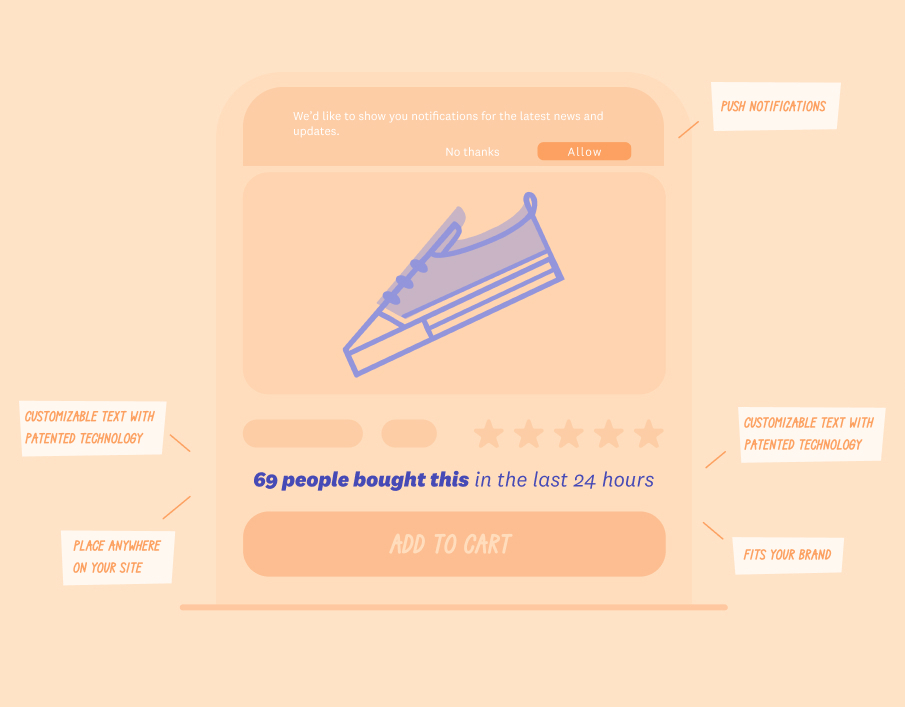Table Of Content

It doesn't matter how optimized your funnel is, or what sexy viral marketing tactics you use. If you can't retain customers, your business is doomed. As business owners and marketers, we get so obsessed with finding ways to attract new customers that we neglect our most valuable customer segment - people who have already bought from us.
Even if you are managing to retain a decent number of customers, you could still improve your customer retention and reduce customer churn. Just think about how much work it is to acquire a new customer. From getting their attention with your content marketing, to nurturing the relationship via an email campaign, convincing them to sign up for a free trial, and finally getting them to buy, it's a long journey. All that work is wasted if they cancel their subscription after a month or never buy another product from your store.
So today, we're going to tackle this problem head on. We'll look at 15 strategies for customer retention. This way, all your careful acquisition efforts won't be in vain. A lot of these strategies will also improve every part of the sales cycle, so you'll have the added bonus of attracting more new customers. Sounds like win-win, right?
Let's get to it.
15 Customer Retention Strategies
Each of these strategies will work no matter what business you're in. Some are more relevant to certain industries (for example, documentation is relevant if you're selling a product, but not so much for consulting), but all are useful. When a tactic is relevant to a certain type of business, we’ll make note of it.
1. Give Superstar Customer Support
No matter what you're selling, customer support is vital. We can't emphasize enough how important this is. Most businesses suck at customer support. Just think about the last time you were on hold for an hour trying to reach your bank. You were cursing their guts the whole time, and you made sure to tell everyone else about your awful experience.
Now, contrast that experience with a company that has superb customer support, such as Amazon. Despite being a huge company, their support is always easy to deal with, whether returning an item or dealing with an unresponsive seller. This is the kind of customer support you tell everyone about, the kind of company that you're loyal to for life.
Of course, you don't need the resources of Amazon to provide excellent customer support. It's as simple as, well, being a decent human being. Even if you're a one- or two-person shop with nothing more than a phone number and email address, you can still provide prompt and courteous answers to customer questions.
All you need to do is empathize with the customer (even if they're being unreasonable). Show them, first and foremost, that you understand what they're going through, and do everything in your power to make it right. This is how you stand out.
2. Provide Superb Onboarding
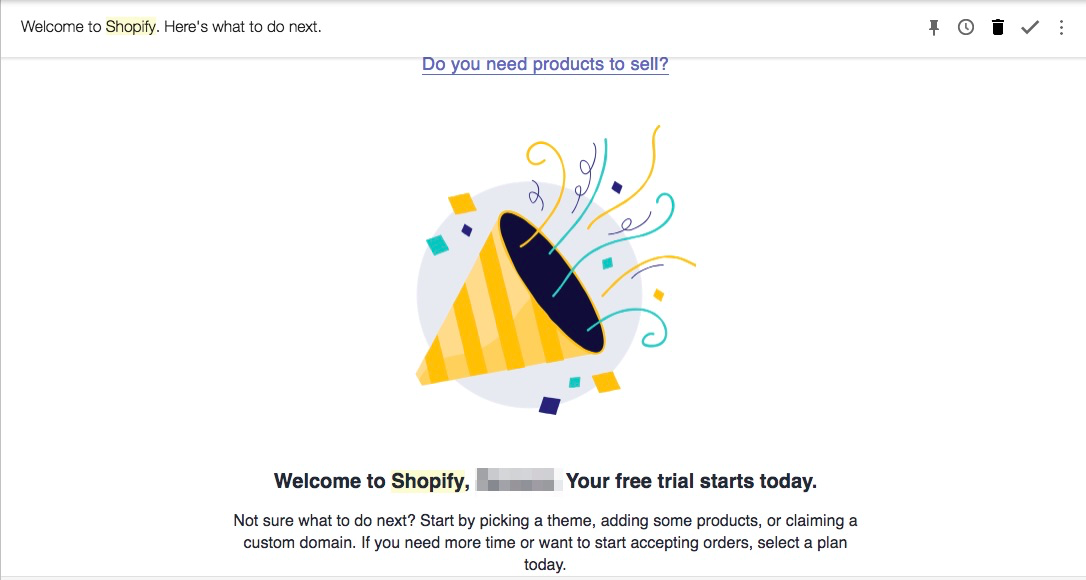
An example of a Shopify onboarding email. Note how it gives actionable steps for the user to take.
If you run a SaaS company, this is crucial. How many times have you signed up for a software product and then cancelled your subscription because you couldn't figure out how the heck to use it? I know I’ve done it a few times. This is a shame, since the product was probably excellent--the onboarding process was where the company failed.
Avoid this churn by providing a pleasant onboarding experience. You can do this in a few ways:
- Integrate onboarding into your interface - The best SaaS apps are onboarding from the moment you first log-in. For example, when you sign up for cloud accounting app FreshBooks, you see a series of pop-up "hints" that guide you through using the software. You can work with your developers and UX/UI designers to build onboarding into your app, making sure to highlight important or overlooked features.
- Gamify onboarding- Along with the above tip, you can turn the onboarding experience into a fun challenge. Create a list of the most common user tasks and display a "success" message or progress bar every time a user completes one. This is a fun way to walk new users through the software and preempt common usage questions.
- Reach out to new users- This goes back to customer support but takes it a step further. I love it when I sign up for a new app and receive a personal message from the head of support, head of product development, or even the CEO asking me to email them if I have any questions. It's also a nice touch to include some links to guides for new users in these emails, as well as a support phone number or chat link (if applicable). Speaking of guides, that brings us to our next tactic: documentation.
3. Create Clear Documentation
No matter how excellent your onboarding and support, customers are going to have additional questions. Whether it’s a use case that’s specific to their industry, or just a feature they can’t find, this is when users turn to documentation.
Documentation can take different forms, and its extent depends on the complexity of your product. A basic app such as Harvest Time Tracking, for example, has just one page of documentation with answers to common questions. Something like Photoshop, on the other hand, has a massive user guide and a dedicated set of tutorials that you can sort by complexity and topic. Given the scale of the product, this makes sense.
When you’re starting out, it can be difficult to anticipate every possible user question. This is why documentation is a constant work in progress and is most effective when used in conjunction with customer feedback (more on that below), but it will evolve as your product does.
Documentation also ties in with ongoing education, which we’ll cover in a moment.
4. Communicate with Customers
The old saying "Out of sight, out of mind" doesn’t just apply to personal relationships--it applies equally to relationships with your customers. If people aren’t thinking about your business or product, they may forget to use it and become inactive.
To prevent this, communicate with your customers. Of course, don’t be spammy--provide value every time you send a customer email or other message. Here are a few types of customer communication to consider:
- Product updates - Any time you implement a new feature, fix a bug, or tweak your site’s design is a perfect opportunity to communicate with customers. If it’s a new feature, let them know how it will benefit them. If it’s a design change, explain your rationale. Whatever you do, don’t spring these changes on people without warning--that’s a recipe for unhappy, frustrated customers.
- Ongoing education- No matter how detailed your documentation, you’re always going to know your product or service more deeply than your customers. This asymmetry of information is a great chance to educate your customers. You can tie in your content marketing with retention, creating posts such as "5 Things You Didn’t Know You Could Do with FOMO". These types of content give customers value and make sure they stay engaged (as well as giving them the opportunity to share content with other potential users).
- Offers or discounts- No matter what you sell, it’s always beneficial to make customers aware of any new offers (or existing ones they may not be aware of). For example, if you offer a discount on annual memberships, let people know! Even if you’re not selling products, perhaps you have affiliate relationships that let you offer your customers a discount on relevant products/services. Paul Jarvis, for example, offers discounts on several relevant products to members of his Creative Class course for freelancers. Whatever you do, don’t assume customers will find these offers on their own--educate them.
5. Increase Website Usability

Google’s PageSpeed Insights tool gives you a quick glimpse at your website’s performance along with tips for improving it.
If your website is hard to use, your business is dead in the water. This should go without saying. If customers can’t use your website, they won’t be customers for long. Here are some ways to make your site more usable:
- Make sure your site is fast - According to a 2017 report from Google, the average load time for a mobile landing page is 22 seconds. However, the same report notes that "53% of visits are abandoned if a mobile site takes longer than three seconds to load". That’s unacceptable. You must have a fast, or nothing else you do matters. To get started speeding up your site, check out this guide from Moz.
- Test site usability - Of course, to improve usability you need data. To get it, we recommend using a tool such as Crazy Egg to see how users are interacting with your site. And, of course, you should be using Google Analytics or a similar tool to see where visitors are spending the most time (and where they’re abandoning key pages).
- Optimize your checkout process - If you’re running an ecommerce store, make sure that it’s easy to checkout. Put as few steps as possible between adding an item and purchasing it. This also applies to sales funnels outside of ecommerce--don’t make it hard to buy your product.
- Make your offer(s) clear - There’s nothing worse than landing on a website that seems to offer a solution to your problem...and then realizing you’re not even sure what the company is selling. This is key if you offer multiple products or services. Make it clear on your homepage what you offer and how prospects can learn more.Again, it should not be difficult to buy your product.
6. Collect Exit Feedback
When a customer cancels their subscription or deletes their account, you need to know why. The simplest way to find out is to ask. Email marketing service Mailchimp, for example, allows you to provide an optional "Unsubscribe Reason Survey" when someone unsubscribes from your list.
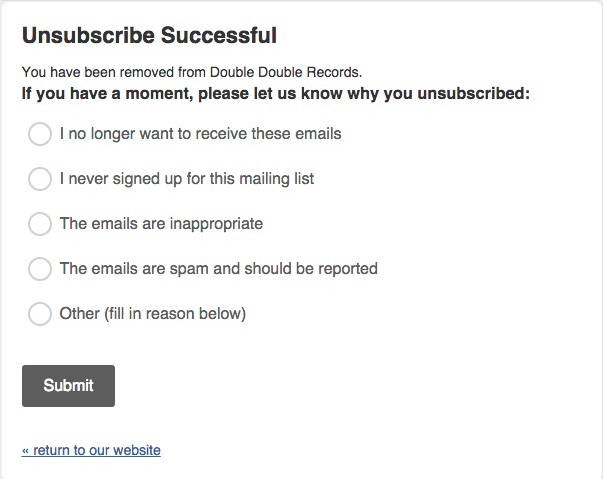
Image courtesy of Mailchimp
Whatever your product or service, you should find a way to collect similar feedback from customers. This way, even if you lose that particular customer, you have data to aid future retention efforts. Just make sure the survey is short and easy to complete while still having targeted, useful questions. For example, you can ask customers if their reason for unsubscribing was the offering of a competitor, or if your price was too high.
7. Collect Ongoing Feedback
Exit feedback should be a last resort. To help preempt customer churn, you should collect ongoing feedback from existing customers. Again, keep these surveys short and simple. If you must have a longer survey, offer an incentive for completing it, such as a discount or account credit (or even an Amazon gift card).
Ask questions such as, "On a scale of 1-10, how likely are you to recommend our product to a friend?" or “In what area can we improve our service?”. There are dozens of tools for creating customer surveys, but we recommend Google Forms or Typeform as two useful, low-friction ways to get started.
One final point: In addition to giving you valuable data about your business, these surveys make you customers feel involved in your company. Once more, it’s all about ensuring that your customers know you’re listening. This brings us to our next tactic:
8. Follow Up On Customer Feedback
You’ll get great data if you give people a survey, but it’s of little benefit to the customer if they don’t know you listened to their feedback. For this reason, it’s imperative that you follow up on the feedback that customers give you. Depending on your organization and offering, this can take different forms.
If you’re in the early stages of your company (or if you sell a super premium product with a small customer base), then following up individually is likely the right approach. Individually following up makes sure your customers know you care, and it also gives you a chance to ask for further feedback in the form of a phone call or more detailed survey. Plus, people will spread the word about this detailed personal attention.
Of course, following up individually isn’t always practical. In this case, you can still follow up on a broader scale. One great way to do this is to write a blog post with a title like "You asked, we listened." You can include a chart summarizing the most popular feedback and then address how you’re going to incorporate it into changes to your product or service. Naturally, you should only address things that you can fix.
9. Offer Discounts When a Customer Cancels
This is another last-ditch tactic, but offering a customer discount when they’re about to cancel their subscription can sometimes help retain them. What you offer is up to you, and you should experiment with the offer to see what works best.
Common examples are a free month or even a yearly discount. It depends what the person is cancelling and what you can afford to offer. Shopify, for example, offers the option to extend your trial period by a week after the initial two-week trial ends. This makes sense in Shopify’s case, since their goal is to convert trial users into paid subscribers.
Giving the user another week free lets them explore the product’s functionality and, more importantly, gives Shopify a chance to double down on other efforts such as email marketing, education, and outreach. You should do the same--if a customer takes the discount and continues their subscription, then be sure to keep communicating with them to ensure they don’t cancel in the future.
10. Employ Social Proof
We talk a lot about social proof here at FOMO, but that’s because it’s powerful in pretty much any interaction you have with a customer. You can read our full post on the topicfor a detailed explanation, but here’s social proof in a nutshell: people are more likely to do something if they see other people doing it (especially if they perceive those other people as similar to them or as authorities).
So how do you use this to increase customer retention? We see two primary ways:
- Use social proof in ongoing education - Case studies derive much of their power from the social proof they provide. So if you can use customer case studies as part of your ongoing customer education, you’re going to give customers the confidence that they should continue using your product (since people like them already do).
- Use social proof when a customer is about to cancel - When a customer goes to cancel their membership, you can show a message like, "Wait, don’t go. 50,000 people trust PRODUCT NAME to get results for their business each day." This works even better if you accompany it with a visual representation of your customers, a couple well-chosen customer photos, or the names of some prestigious companies/people that use your product. People want to conform to social expectations, so leverage that tendency when they’re about to cancel.
11. Be Personal
This continues one of the article’s ongoing themes: connecting with your customers in a genuine way. The basic principles of human connection go a long way toward keeping your customers around. Here are a few basic techniques to connect with customers in a personal way:
- Use their name - As Dale Carnegie put it, "Remember that a person's name is to that person the sweetest and most important sound in any language." Whenever you email a customer, begin by greeting them with their name. The same goes for when providing customer support (this is all the more important if it’s over the phone). Really, it makes a difference.
- Make some small talk - Along the same lines, don’t be afraid to inject a little small talk. Phone support reps do this all the time, asking you how your day is going or chatting about the weather. You don’t want to be nosy or creepy, of course, but a bit talk like this shows the customer you care and turns the support interaction into more of a, well, real human interaction.
- Give support on social media - Offering support on social media is a popular tactic these days. It has the obvious benefits of being both responsive and relevant (as opposed to something like email, which people check less). But even more than that, social media is more personal than email or formal company support. It’s also great if you’re a small company and can’t afford more comprehensive support software.
12. Create a Referral Program
Referral programs are a popular way to grow your customer base, but they can also work well to retain existing customers. When customers take place in a referral program, they get the benefit of whatever incentive you offer them, whether it’s a discount, a cash payout, or a chance to win a free product.
But beyond that, it also gets them involved in your business, making them feel invested in your success. And an invested customer is a loyal customer. Furthermore, it builds the habit of sharing info about your company with their family, friends, and followers. This does nothing but benefit your business.
13. Use a Subscription Model
Just think of all the superstar businesses that are built on subscriptions. Amazon Prime, Netflix, Dollar Shave Club, Dropbox, and Nature Box are just a few off the top of my head. Subscriptions have the obvious benefit of providing predictable, recurring revenue. But beyond that, they also improve customer retention.
A subscription eliminates lots of friction from the buying process. For example, I don’t have to think about renewing my Amazon Prime membership each year--it just happens. This is convenient to me as a customer. To offer otherwise would be a disservice.
Of course, you have to be careful. Particularly with yearly subscriptions, you should be sure to communicate with customers when the subscription is about to renew. Failure to do so can result in customers who are angry or confused about the charge. This is also best practice if you start customers on a free trial that then turns into a paid subscription. Avoid nasty surprises and let customers know when the free trial is about to end.
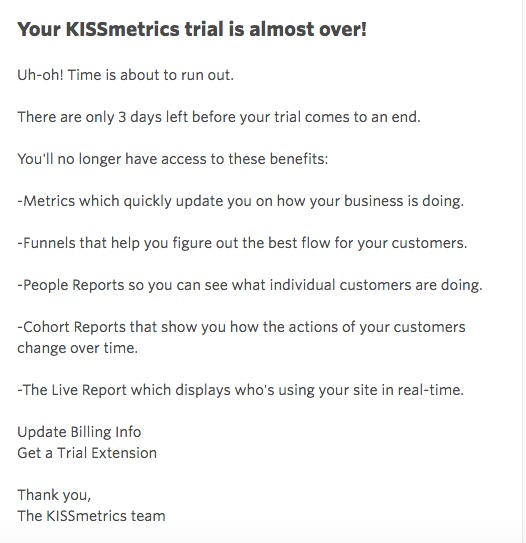
This "trial ending" email from analytics software KISSmetrics shows the right way to alert a customer that their trial is ending while reminding them of the benefits of subscribing (Image courtesy of Just Good Copy).
Naturally, you need to frame this in the right way. When you tell a customer that the free trial is almost over or that the renewal date is coming up, emphasize all the benefits of the membership. Let them know of benefits they might not even be aware of, and provide links to resources that further educate them of the benefits.
14. Express Your Gratitude
We know you’re grateful that you have customers--you wouldn’t be in business without it. Don’t keep this gratitude to yourself. Let your customers know. Whether it’s sending them a handwritten thank you note with their purchase, giving them a free gift on the anniversary of their subscription, or just sending a simple thank you email, customers love to hear positive things.
Just think of all the horrible spam and self-promotional inbound that you receive every day. A little gift or expression of gratitude amidst that onslaught is a wonderful thing. So give that gift to your customers and watch as they return the favor with their continued patronage.
15. Focus on Retaining the Right Customers
To wrap up, we must note that you should focus on retaining the right customers. The best businesses exist via differentiation. And along with that comes exclusion. "Everyone" is not your customer, and that’s how it should be.
So don’t waste your effort on retaining someone for whom your offer is a bad fit. Let that customer go, and focus your efforts on delighting the customers that benefit from your product, the ones with the potential to grow with your company and become evangelists for your brand.
Trying to please everyone is a surefire way to end up pleasing nobody.
Customer retention is a never ending process for any business. The effort is worth it, however, as it lets you tap into your best prospects: existing customers. Of course, you shouldn’t give up on attracting new customers, but you should always be exploring new ways to boost customer retention.
To use social proof to attract and retain customers, check out FOMO. By displaying visitor activity in real time, FOMO can help you show prospective customers what they’re missing and remind existing customers why they’re sticking around.




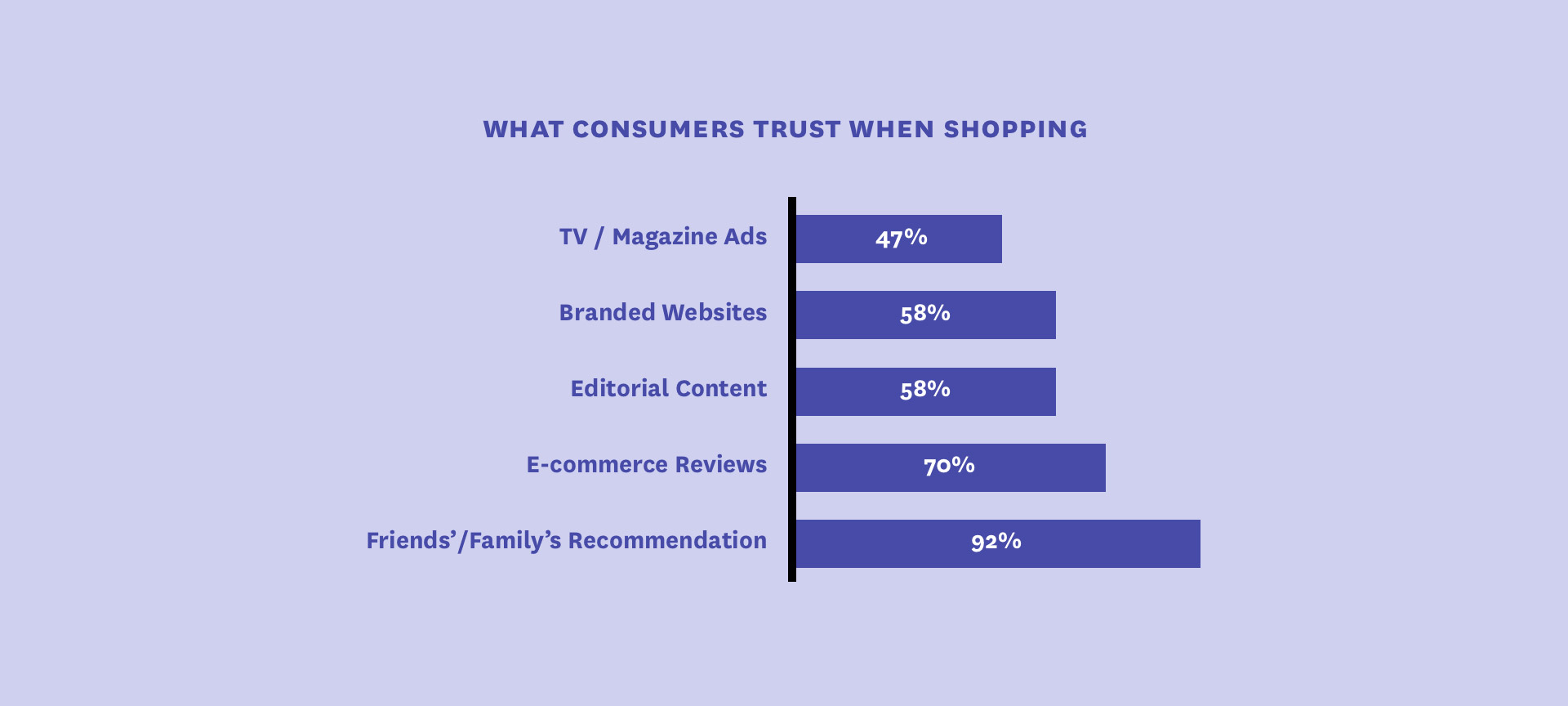
 1.svg)
 1.svg)
